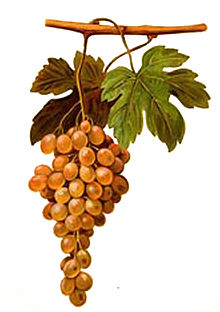Pedro Ximénez
| Pedro Ximénez | |
|---|---|
| Grape (Vitis) | |
 Pedro Ximénez in Viala & Vermorel | |
| Color of berry skin | Blanc |
| Species | Vitis vinifera |
| Also called | PX, Pedro Jiménez, (more) |
| Origin | Spain |
| Notable regions | Montilla-Moriles, Jerez, Australia, Chile, |
| Notable wines | Pedro Ximénez |
| VIVC number | 9080 |
Pedro Ximénez (also known as PX and many other variations) is the name of a white
Historically Pedro Ximénez is grown in Australia to make fortified wines and sherry type wines known by the Australian term - Apera. It is often used for blending and to make botrytised dessert wines and still lends itself in the Swan Valley to the making of dessert wine today. This grape variety has thrived in Western Australia's Swan Valley since its introduction there due to the hot climate growing conditions. The vine requires a rich soil and short pruning.[2] James Busby brought some Pedro Ximénez to Australia in 1832. Some were imported from Jerez and planted at Clarendon; a transfer from the Sydney Botanic Garden is recorded in around 1839.[3]
Pedro Giménez (Pedro Jiménez) is a widely grown criolla variety in South America whose relationship to Pedro Ximénez is uncertain, as it shows ampelographic differences.[4]
History

There have been several apocryphal legends about the grape's origins. In 1661, the German ampelographer
Today ampelographers believe that Pedro Ximénez probably originated somewhere in the
The origin of the name Pedro Ximénez is not yet clear with French ampelographer
Viticulture

Pedro Ximénez is a
Relationship and confusion with other grapes

DNA evidence has shown that Pedro Ximénez is an offspring variety of the Arabic table grape Gibi and a half sibling to Alarije. In 2007, it was also confirmed that the table grape Corinto bianco was a seedless
At one point it was thought that Pedro Ximénez was related (or possibly identical) to the German wine grapes Elbling and/or Riesling; but in addition to DNA evidence disproving a relationship, viticultural evidence had shown for many decades that Pedro Ximénez requires a much warmer climate than most German wine grapes in order to fully ripen, and was thus not likely to be closely related to any German wine variety. Other grapes that are sometimes confused with Pedro Ximénez include the
Wine regions
Spain

Pedro Ximénez is most widely grown in Spain, where there were 6,950 hectares (17,200 acres) of the grape in cultivation as of 2019. The vast majority of these plantings are found in the
The grape can also be found in the
In 2008, plantings of Pedro Ximénez were found in Spain in the
Outside Spain

In 2010, there were 350 hectares (860 acres) of Pedro Ximénez planted in
In South America, most of the plantings of the grape known as Pedro Ximénez or Pedro Jimenez used in
In
Other uses
When the casks used to age Pedro Ximénez Sherry are retired, they are often sent to Scotland and Ireland, where they are used to age fine whisky. Single malt whisky aged in sherry casks is regarded by some as a special category with its own aficionados. The sweet Pedro Ximénez wine infused in the wood of the casks imparts some of the flavor and aroma of the wine to the whisky during the ageing process. In the whisky industry the taste of the Pedro Ximénez is very sweet. Most of the whiskies that get this treatment are only finished in Pedro Ximénez casks for a relatively short time, after spending the bulk of their maturation time in other casks. The Pedro Ximénez sweetness is often combined with a smoky peat flavor.[5]
Synonyms

Over the years, Pedro Ximénez has been known under several synonyms including: Alamais, Chirones, Corinto bianco, Don Bueno, Jimenez, Pedro, Himenez, Ximénez, Ximénès, Pedro Jimenez (in Andalusia), Pedro Khimenes, Pedro Ximénès, Pedro Ximenes (in Andalusia), Pedro Ximenez, Pedro Ximenez Bijeli, Pedro Ximenes De Jerez, Pedro Ximenez De Montilla, Pedro Ximinez, Pero Ximen, Perrum (in the Alentejo region of Portugal), Peter Siemens,[6] Pasa Rosada De Malaga, Pierre Ximenes, Uva Pero Ximenez, Uva Pero Ximen, Uva Pero Ximenes, Pero Ximenez, Ximen, Ximenes (in Andalusia), Ximenez, Alamis De Totana, Alamis, Myuskadel, Verdello (in the Canary Islands), Ximenecia, Zalema Colchicina and the abbreviation PX (in Andalucía).[1][7]
References
- ^ ISBN 978-1-846-14446-2
- ^ Despeissis, Adrian., The Handbook of Horticulture and Viticulture of Western Australia (1921 ed.) p277.
- ^ Radden, Rosemary. "Grapes and Wines of the World". The State Library of South Australia, GPO Box 419, Adelaide SA 5001. Retrieved 2007-04-14.
- ISSN 0717-3458Vol. 6 No. 3, Issue of December 15, 2003
- ^ Pedro Jimenez casks are also now popular with rum production.Pedro Ximenezs cask finish on Whisky.com
- ISBN 3-8001-5719-5.
- ^ Vitis International Variety Catalogue (VIVC) Pedro Ximénez Archived 2016-09-01 at the Wayback Machine Accessed: January 24th, 2014
